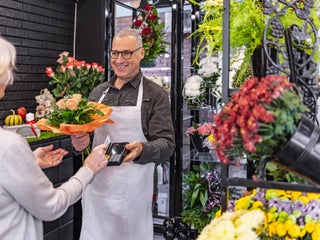Summary
As COVID-19 hit, consumers increased their use of already popular P2P payment services to decrease the handling of paper money (and the germs associated with it). If you’re unsure which P2P is best for you, here are the features to be aware of when choosing an app.
The content on this page is accurate as of the posting date; however, some of our partner offers may have expired. Please review our list of best credit cards, or use our CardMatch™ tool to find cards matched to your needs.
Venmo, PayPal, Zelle – these payment apps, and others like them, seem tailor-made for the time we’re in. Peer-to-peer (P2P) payment apps were already surging in popularity – and then the pandemic hit.
Like other forms of electronic payment, P2P apps have seen steady growth during a time when people are increasingly loathed to handle cash and coins.
“We are definitely seeing an increase in transaction volumes in these apps,” said Eric Kraus, vice president of fraud risk and compliance solutions for FIS, a company that provides technology and service to financial institutions.
Generally, usage of P2P apps increases at the end of the calendar year, then dips again in the second quarter, said Jaclyn Holmes, who manages consumer research at Auriemma Group. Analysts think that may be because people get new phones for Christmas, add the apps as they try out their new gadget, then fall away once the novelty wears off. But this year, use continued to climb even as winter turned to spring, she said.
That may be in part because many consumers opted to have their federal pandemic stimulus checks deposited directly into a P2P app, Kraus said. But that’s far from the only transactions people are doing with these apps.
These apps have proved so convenient that 71% of American adults have used P2P payment platforms, according to an April 2020 survey sponsored by the AARP. Nearly two-thirds of adults use the services sometimes or frequently.
“It really solves a payment problem,” said Sarah Grotta, a director at Mercator Advisory Group. “These smaller payments, where you need to pay someone in person, this makes it much easier.”
Thinking about trying one of these yourself? Unsure where to start? Read on to learn how these apps work, your various P2P app options, and what you need to know about fraud when using one of these apps.
See related: How to use cashless payment systems without overspending
How to choose a P2P payment service
What P2P payments are, how they work
Think of the apps as vehicles, getting you where you want to go. They allow users to send money to one another from their mobile device by linking a bank account, credit card or debit card to the app. Each one operates a little differently (see below for details), but all involve linking an outside source of money to the payment service.
So, for instance, you’re about to buy something online and up pops an option for using PayPal. If you’re enrolled in the service and click on the link, you will be presented with options for payment. What those options are depends on what you’ve linked to your PayPal account: a credit card, a debit card, a bank account or all three, or some combination of cards and accounts.
Or, say your neighbor texts you and says she’s going to the market, “Do you want anything?” You ask her to get you a couple of items. When she returns with the groceries, you can pay her with cash, rounding up or down if you don’t have exact change. You can write her out a check. Or you can open up the app of your choice, find your neighbor in your contact list, enter the exact amount you want to send and that’s it!
To sign up for the apps, you will likely be asked to provide an email or a mobile phone number. If you want to pay a friend or service provider on apps like PayPal and Zelle, you will need their email address or mobile number to find them.
P2P payment services
There are many different P2P and social media payment options out there. To keep it simple, here’s a breakdown of six popular options.
PayPal
The granddaddy of them all, PayPal is the original P2P service. It allows users to transfer money from a bank account to friends and family, without fees, and with a credit or debit card for a 2.9% fee within the U.S. Many online merchants also use PayPal as a payment option at checkout.
PayPal has higher transfer limits than most P2P services. You can send up to $60,000 in a single transaction – though you may be limited to $10,000. The amounts vary depending on your currency.
Venmo
Venmo is owned by PayPal but operates differently. It’s much more app-centric, less reliant on emails and phone numbers – and thus popular with a younger crowd because it connects users through their friend groups.
Venmo charges a 3% fee to send money using a credit card, a 1% fee for an instant money transfer (minimum of 25 cents, maximum of $10). All other transactions and transfers are free.
One of Venmo’s most interesting standouts is that the app also offers a free, optional debit card. It allows users to spend money from their Venmo account balance using a physical card.
Zelle
Zelle is an app but many users discover it through client banks. Zelle competes with stand-alone P2P apps as a free way to send money electronically, directly to and from bank accounts, to friends and service providers/merchants.
Banks will also send businesses money for you, but this often means the bank printing an actual check and mailing it. Zelle is compatible with many banks and credit unions, making it easy to transfer money without needing to move it out of a third-party app.
Cash App
Cash App was formerly known as Square Cash before a rebranding. It also levies a 3% credit card fee and a 1.5% fee for instant transfers.
Cash App offers a debit card called the Cash Card, which allows users to spend money from their Cash App balance. Users also have the chance to trade stocks on the app and convert dollars to bitcoin.
Google Pay
Google Pay sets up a little differently from the others. The service is always free, but your options are constrained by the card or account you use.
You can use a debit card or a bank account to send money to other people. A lot of retailers also accept Google Pay as a form of payment. If a merchant has a point-of-sale system with an NFC reader, you can just tap your smartphone at the kiosk to pay.
Apple Pay Cash
With Apple Pay Cash, you can send and receive money through messages on your iPhone by linking your debit card to your Apple Wallet. For instance, if your sister messages you that the present she bought for your mom was $50 and you owe her $25, you’ll receive a pop-up asking if you’d like to pay her directly, right then and there. And there are no fees for sending money using Apple Pay Cash.
Like Google Pay, you can use Apple Pay at many retailers – as long as they have a POS system with an NFC reader. And while useful, Apply Pay Cash can’t be used on Android devices.
See related: Guide to mobile wallets: Samsung Pay, Apple Pay, Google Pay
Social media money transfers
Some social media networks like Facebook allow users to send P2P money transfers in the form of messages (similar to Apply Pay Cash). With Facebook Pay, users link their bank account, debit card or PayPal account and can then send and receive money through Facebook Messenger.
If both parties are enrolled in Facebook Pay, money transfers are almost instant. The app also allows users to purchase games, make donations to a charity or a personal fundraiser, and buy and sell items on Facebook marketplace or through groups.
Most transactions are free on Facebook Pay, but exceptions include any fees charged by PayPal, fees charged to people receiving money for personal fundraisers and those selling items on marketplace.
Pros and cons of using a P2P payment service
In the AARP survey, respondents were asked whether, if they inadvertently sent the wrong person money through Venmo, PayPal, or another P2P app, they would be able to recover the money. More than half of the respondents answered yes. But that statement can be false. The banks involved (through a credit or a debit card) may choose to refund the payment, but that’s at their discretion. The apps themselves are under no requirement to do so.
“It can certainly be more challenging for consumers to recover funds used in fraudulent P2P transactions,” said Kraus.
That is why experts caution you should only send money with these apps to people that you know. Consider this: Since 2016, the number of fraud victims associated with P2P payments has shot up by 733%, according to an April 2020 Javelin ID fraud study (the AARP’s statistics, referenced above, were culled from this study, which the organization helped sponsor).
Criminals used to traffic in counterfeit credit cards, but that avenue has largely been shut down by embedded chips in the cards. They’ve since turned their attention to online fraud and P2P apps, where they attempt to take over accounts, or start new ones in someone’s name, and then quickly drain bank accounts by sending payments, according to Kraus.
See related: No card, no sale: How a cashless society is leaving some behind
Consumers can protect themselves by being “as proactive as you can,” he said, suggesting users “sign yourself up for real-time, mobile transaction alerts.”
Many apps also come with fraud monitoring and support teams to help users resolve unauthorized transactions.
Looking ahead, some of these apps may decide to take their cues from what’s going on overseas, Grotta said. In China, for instance, Alipay users can order food through their app, or a ride or invest in mutual funds, she said. Cash App, with its capabilities for stock market interaction, is already heading in that direction.
Banking in particular “could be an interesting platform for these apps to expand into,” she said. “They’ve already added the purchasing capabilities … It would make a lot of sense.”
Best peer-to-peer payment apps
Depending on your needs, one P2P payment app might be more beneficial than another.
| App | Benefits | Drawbacks |
| PayPal |
|
|
| Venmo |
|
|
| Zelle |
|
|
| Cash App |
|
|
| Google Pay |
|
|
| Apple Pay Cash |
|
|
Final thoughts
As long as you’re cautious about the way you use a P2P app, they can be a useful alternative to paper money and coins. Which one you choose ultimately comes down to convenience and figuring out where you do most of your transactions and with whom.
Editorial Disclaimer
The editorial content on this page is based solely on the objective assessment of our writers and is not driven by advertising dollars. It has not been provided or commissioned by the credit card issuers. However, we may receive compensation when you click on links to products from our partners.



